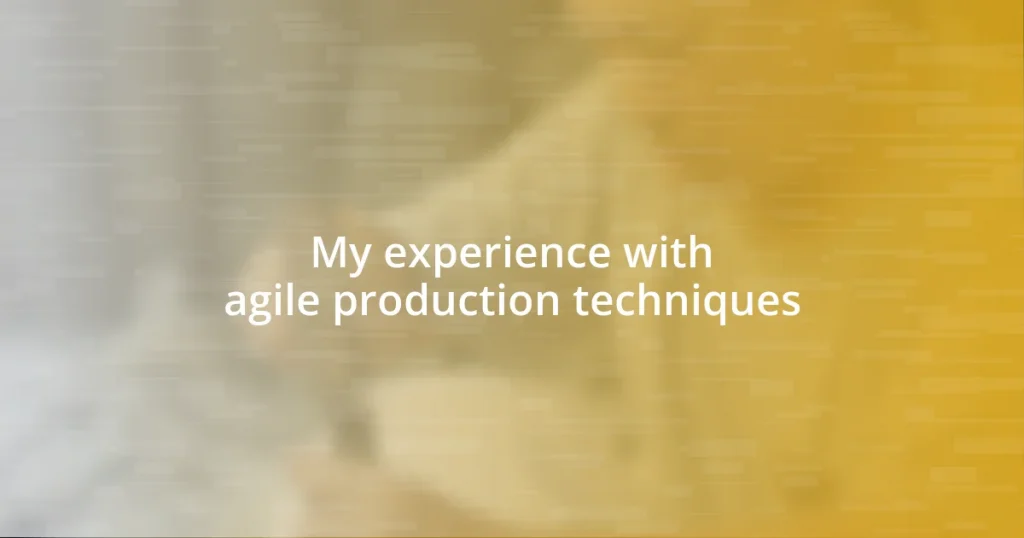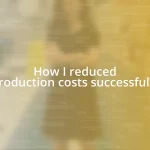Key takeaways:
- Embracing agility through daily stand-ups and collaboration transformed team dynamics, fostering accountability and support.
- Shifting focus from just meeting deadlines to prioritizing customer feedback led to stronger client relationships and improved project outcomes.
- Continuous improvement through regular retrospectives and open discussions about successes and challenges enhanced team performance and trust.

Understanding Agile Production Techniques
Agile production techniques are all about iterative progress and flexibility, which I learned firsthand during a project where we struggled with strict deadlines. I remember the moment we decided to shift our approach – it was like a breath of fresh air. We broke our work into manageable chunks, and suddenly, the stress melted away; we were able to adapt based on feedback and see tangible outcomes each sprint.
Why is adaptability so crucial in today’s fast-paced environment? It’s because the landscape is constantly changing. For instance, in one of my earlier projects, our client pivoted mid-course. Thanks to agile techniques, we were able to realign our goals without losing momentum, which is something I’m sure many teams can relate to. It’s these experiences that teach you the value of being responsive and open to change.
One of the most profound insights I’ve gained through implementing agile practices is the power of collaboration. I recall one instance where daily stand-up meetings transformed our communication. It was incredible to see how sharing quick updates not only kept us accountable but also fostered a culture of support and visibility. Isn’t it fascinating how a simple routine can reshape team dynamics and lead to greater success?

Benefits of Agile Practices
Agile practices offer remarkable benefits that can truly transform how a team operates. During one project, the shift to agile methods helped us enhance not only our productivity but also the team’s morale. When we began breaking tasks down into sprints and reviewed our progress regularly, it felt like we were celebrating small victories along the way. That sense of accomplishment ignited our motivation and pushed us to strive for continuous improvement.
Here are some key benefits that I’ve experienced firsthand with agile practices:
- Increased Flexibility: The ability to pivot quickly based on feedback allows teams to stay relevant.
- Enhanced Team Collaboration: Regular check-ins foster synergy and build trust among team members, leading to better results.
- Faster Delivery of Value: Iterative work means we can release parts of the project sooner, providing immediate value to clients.
- Greater Transparency: Everyone knows what they’re working on, which helps reduce misunderstandings and promotes accountability.
- Improved Customer Engagement: Involving clients in the process ensures their needs are prioritized, leading to higher satisfaction.
Reflecting on these aspects, I can genuinely say that embracing agile practices has not only optimized our workflow but has also turned our projects into more enjoyable and fulfilling experiences.

My Initial Agile Project Experience
When I first jumped into an agile project, I was both eager and hesitant. I vividly remember our kickoff meeting—there was a buzz in the air, but I also felt a tingle of uncertainty about how we’d collaborate in this new framework. As we progressed, embracing daily stand-ups became a game-changer for me. I found joy in sharing my updates, and honestly, it turned what felt like a daunting process into a supportive roundtable. It was enlightening to watch how this simple practice made each team member accountable, and it ignited a sense of community.
In another instance early in the project, we faced a significant roadblock that could have derailed our timeline. Rather than feeling helpless, the agile framework allowed us to come together, evaluate our situation, and pivot our strategy. I experienced a rush of adrenaline when we broke down the problem into smaller tasks and assigned them to different team members. It was like watching a complicated puzzle come together piece by piece, and seeing my colleagues step up to tackle challenges with creativity and enthusiasm was honestly inspiring.
As we navigated our sprints, I discovered that our iterative approach transformed my perspective on success. Each small completion felt like a milestone, filling me with pride and motivation to push forward. I still cherish those moments when our team gathered to review what we achieved, clinking our coffee mugs in celebration. That camaraderie became a driving force, and through every challenge, I learned that agile isn’t just a methodology; it’s about nurturing a culture of collaboration and resilience.
| Challenge | Agile Response |
|---|---|
| Initial Uncertainty | Daily Stand-ups foster accountability and support |
| Significant Roadblock | Collaborative problem-solving and task reassignment |
| Milestones Feeling Distant | Iterative approach creates celebrations of small victories |

Key Agile Tools and Frameworks
One of the agile tools I’ve found particularly valuable is Trello. When I learned to use it, the intuitive card-and-board system transformed how I visualized tasks and progress. Each list symbolizes parts of our workflow, and moving cards to signify completion feels incredibly satisfying. Have you ever experienced that rush when you check something off your to-do list? It’s that same thrill, amplified by the team’s collective effort and the instant visual feedback.
Scrum, on the other hand, introduced me to the concept of time-boxed iterations known as sprints. I recall our first sprint planning meeting; it was a whirlwind of excitement and focus. We dissected tasks, estimated efforts, and assigned responsibilities. The energy in the room was palpable! I’ll never forget how engaging it was to see everyone contribute ideas. That collaboration not only molded our project direction but also fostered a true sense of ownership within the team. Isn’t it rewarding to know you’re actively shaping outcomes?
Then there’s the retrospective meetings, which I initially viewed with skepticism. Reflecting on a sprint seemed daunting. However, I soon recognized their power for growth. Each session turned into a safe space for constructive feedback, where we could share our highs and lows. Watching the team evolve and adapt from those discussions felt like witnessing a plant blooming after nurturing it with care. It’s amazing what honesty and reflection can cultivate, isn’t it?

Overcoming Challenges in Agile
Navigating the challenges of agile production techniques can sometimes feel overwhelming, especially when initial uncertainty creeps in. I remember one sprint when our team was unsure about our direction because the requirements kept shifting. Instead of retreating into confusion, we utilized collaborative brainstorming sessions to clarify our goals. It was a relief to see how open dialogue cleared the fog and transformed our anxiety into a focused plan. Have you ever found that just talking things out can unlock clarity?
As we faced significant roadblocks, the agile approach really shone. I distinctly recall a pivotal moment when we encountered a critical issue that could’ve stalled our progress. Instead of panicking, we rallied as a team and broke the challenge down into manageable tasks. Witnessing this collective problem-solving was exhilarating—each member’s unique perspective created a tapestry of solutions. It’s fascinating how adversity can enhance teamwork, isn’t it?
Celebrating the small victories was another revelation for us. Initially, it felt like we were racing toward an elusive finish line, but I learned to savor each completed task. One day, after finishing a particularly tough sprint, we gathered for a brief celebration with snacks and high-fives. It wasn’t just a break; it was a moment of recognition for all our hard work, and the smiles on everyone’s faces reminded me how important it is to acknowledge progress, no matter the size. Don’t you think those moments of joy help fuel our motivation?

Measuring Success in Agile Projects
Measuring success in agile projects can often feel like a balancing act. I remember when we decided to focus on delivering value rather than just chasing deadlines. One particular project saw us prioritize customer feedback over our original scope, and that shift not only strengthened our relationship with clients but also resulted in a product that truly met their needs. Isn’t it incredible how what we initially perceive as “success” can change so dramatically?
In my experience, quantifiable metrics play a significant role, but they shouldn’t be the only measure. During one retrospective, we discussed our velocity—a metric showcasing how much work we completed in a sprint. While it’s useful, we also realized that focusing solely on numbers masked the importance of team morale and collaboration. I’ve always believed that a happy team ultimately drives successful outcomes. Have you found that the energy of a team can impact project quality in tangible ways?
Another powerful success indicator for us became the ability to adapt and learn. In one project, after receiving client feedback, we pivoted our approach midway through development. Watching the team embrace the change rather than resist it was enlightening. Success isn’t just about delivering on time; it’s about growing together and navigating challenges with resilience. Wouldn’t you agree that the ability to adapt is a vital trait in any successful project environment?

Continuous Improvement in Agile Production
Continuous improvement in agile production is at the heart of what makes this methodology so effective. I recall a moment when we implemented regular feedback loops after each sprint. During one of our retrospectives, a team member remarked how our small adjustments based on feedback led to a noticeable increase in quality. Isn’t it amazing how just a little reflection can create such powerful shifts in performance?
I’ve found that fostering a culture of experimentation significantly enhances continuous improvement. On one occasion, we decided to trial a new tool that promised to streamline our workflow. At first, it felt daunting, but as we collectively navigated the learning curve, I could see our efficiency beginning to blossom. This experience taught me that embracing change, even when it’s uncomfortable, is essential for growth. Have you ever taken a leap into the unknown and uncovered unexpected benefits?
Moreover, the practice of sharing successes and challenges openly strengthens team dynamics. I remember a particularly enlightening meeting where we discussed not only what went well but also what didn’t. There was an energy in the room that emphasized vulnerability; it became clear that discussing our setbacks was just as crucial as celebrating our wins. I’ve learned that this level of openness cultivates trust within the team—do you think honesty about failures can lead to stronger collaborations?















